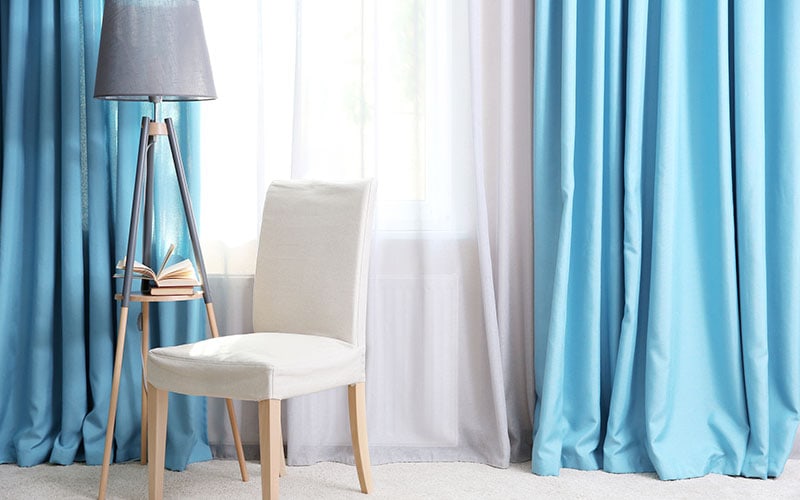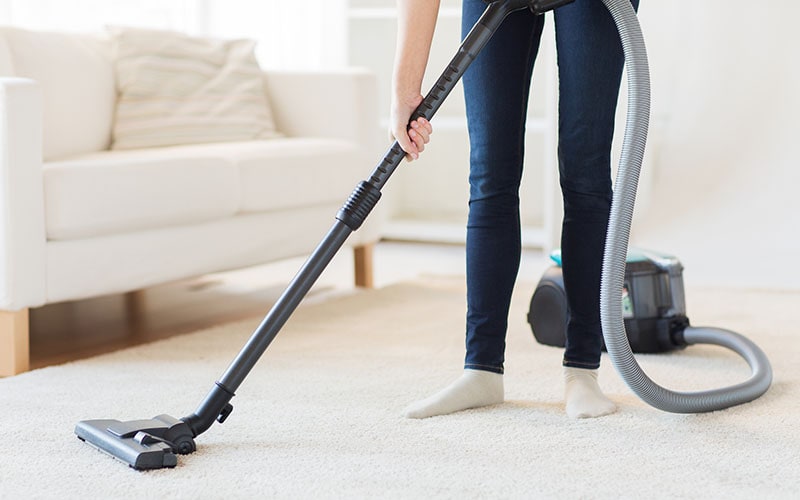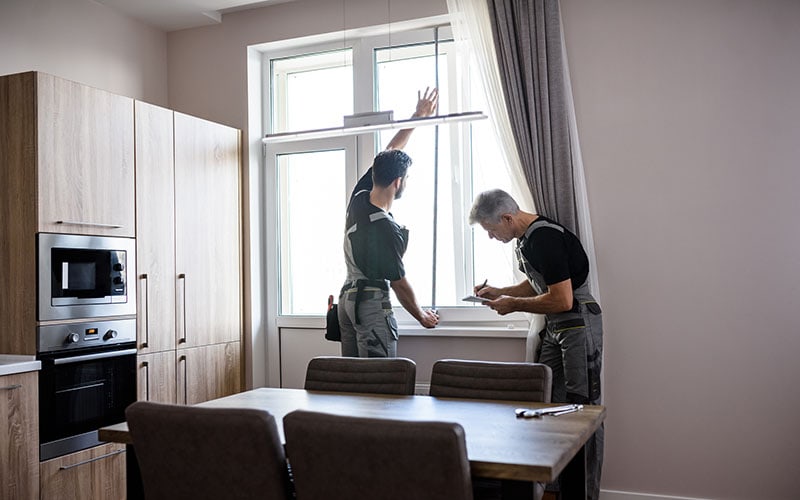Whether you’re hanging curtains in a nursery or your living room, the question of whether they should touch the floor can be an important one.
You may have heard many opinions and may be left wondering what the best solution is for your specific home and your style.
The most common and popular curtain length extends completely to the floor.
This is because it can create a long, vertical line in the room and make ceilings seem higher.
If you have tall windows, this length will also allow for more sunlight to come into your home.
However, the length of the curtain isn’t the only consideration to make when choosing the best curtains for your home.
With this in mind, let’s take a look at the different factors that go into making this decision and what you should consider to find your perfect fit.
Table of Contents
Do Curtains Look Best When They Touch The Floor?

Curtains that extend to the floor are very popular because they create a long, vertical line in the room.
This can result in ceilings looking higher and more open space.
If you have high windows, this length will allow even more sunlight to come into your home.
There are a few different hanging methods you can choose from when it comes to installing floor-length curtains.
When deciding which is the best for your home, you should consider the weight and style of the curtains you’ve chosen, the types of windows you’ll be hanging them on, and your personal style preferences.
Then you will want to choose one of the following floor-length curtain styles; puddle, break or hover.
These three hanging styles can be used to achieve different looks and provide a variety of flexibility.
The Puddle Method
This is a very traditional look that creates a soft, fluid appearance.
You will want to add about 6 to 16 extra inches of material past the floor to create a “pooling” effect on top of your floor.
This curtain hanging method works well for double drapery panels hung high on the wall.
This effect is best with heavier drapes since pooling them on the floor will reduce the weight on the curtain rod.
Thicker curtains can also hold up better to the wear and tear that can occur on the floor.
Some drawbacks to this style include the fact that it can be difficult to open and close your curtains if they’re too thick.
It’s best to puddle your curtains in areas where you won’t be opening and closing your drapes regularly.
The Break Method
Also known as the trouser break, this method creates a more modern look with an appearance that is similar to the puddling style in that it slightly passes below the length of the floor.
It involves hanging your curtains so they are just one to three inches longer than the ground.
This results in a shorter vertical line than when using the puddle method, which can be perfect for smaller or lower windows.
This curtain hanging method works well for single panel drapes or traditional, non-pleated sheers.
This also makes it easy to open and close your curtains, since they aren’t too long or heavy.
It will also be easier to keep these curtains clean and looking good since only a small amount of the fabric will touch the floor.
The Hover Method
This curtain hanging method provides a clean, more modern look that is ideal for smaller spaces and rooms with lower ceilings where you don’t want to make your ceiling appear higher by using longer curtains.
To hang curtains in this style, you will want to install them two-thirds of an inch to one inch above your flow.
This will result in a smaller vertical line and provide a clean, streamlined appearance.
This is the perfect style if you want to keep the hem of your drapes clean and avoid getting debris or pet hair on them.
It’s great for minimal spaces that emphasize straight, simple lines.
This hanging method also works very well with patterned curtains since they will hang straight and the images won’t be distorted by pooling or breaking methods.
How To Take Care of Your Floor-Length Curtains

There are a few things to take into consideration if you want your floor-length curtains to last.
You should vacuum or brush the fabric regularly to avoid dirt buildup that can cause fading, stains, or damage to the fibers of your drapes over time.
Taking good care of your windows also helps to keep your curtains looking great.
It’s best to clean your windows before hanging drapes so you don’t get dirt or other residues on the fabric, which can cause staining and damage over time.
Make sure to dust and wipe down your window interiors at least once a month.
It’s also important not to overload rods with too many curtains if possible, since this puts additional weight on them that could lead to drooping, sagging, or breaking of the curtain rod.
Finally, treat your floor-length curtains like you would any other piece of furniture in your home.
This means taking care to protect them from spills and protecting the floor underneath with a rug or mat.
Tips for Installing Floor-Length Curtains

Now that you know how to choose the hanging style that’s best for your home, here are some specific tips on getting them installed to your liking.
Measure the Length of Your Wall, Window, and Curtains.

The first step is to measure the length of floor-length curtains needed in each room and add an extra inch or two per window depending on how much space your drapes will cover when fully open.
You should also measure the height of each window frame or door in order to find out exactly where you will need to place your curtain rod.
Decide on Curtain Rods and Hardware.
After measuring these dimensions, decide on which type of hanging hardware you want to use.
There are several options when it comes to hanging your floor-length curtains, depending on the style you choose and whether you have multiple windows in one room that will be hung together.
Single curtain rods are the simplest option.
They are installed right above your window frame and hold one curtain panel that can be left to puddle on the floor or pleated to create a more formal look.
Double curtain rods are great for two-panel drapes that need to be puddled or separate curtains hung back-to-back.
They can also hold a decorative valance as well as draperies, which makes them an excellent choice if you don’t have much wall space in your room.
Tension curtain rods are an excellent choice because they are easily adjustable and can be shortened if needed.
These can be adjusted to fit any window or sliding door, so you will only need one type of hardware for all your windows instead of multiple curtain rods depending on the size and shape of each frame.
Final Thoughts
Curtains don’t just provide the functionality to a room.
They also help to unify your home décor with the rest of your space.
Curtains that touch the floor are a timeless and classic style.
There are a couple of different ways that you can achieve this look and you’ll want to consider what types of curtains you have and how you will be hanging them to decide on the best method for your home.
The main thing is to make sure that they look beautiful and hang perfectly whether puddled, hovered, or pooled in a particular style.
Taking the time to choose the right style for you will help you to have a successful installation that will provide years of enjoyment.
Related:
